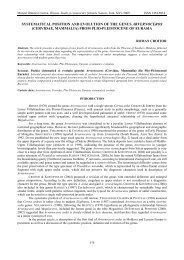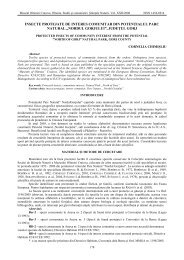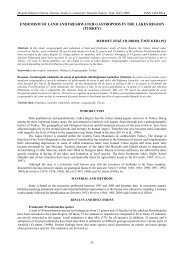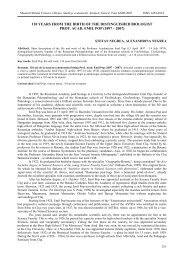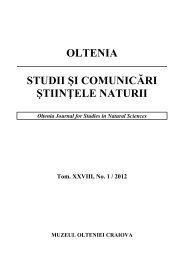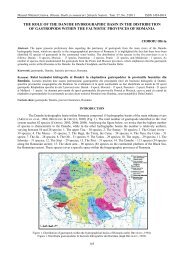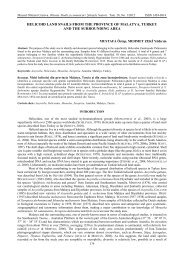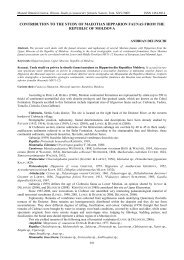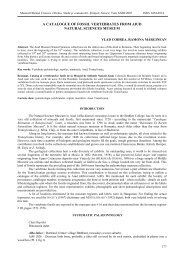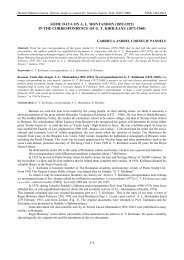You also want an ePaper? Increase the reach of your titles
YUMPU automatically turns print PDFs into web optimized ePapers that Google loves.
Muzeul Olteniei Craiova. Oltenia. Studii i comunicri. tiinele Naturii, Tom. XXV/2009 ISSN 1454-6914<br />
WHEN DID THE DANUBES BECOME THE DANUBE?<br />
319<br />
ION ANDREESCU<br />
This paper is dedicated to Professor PETRE COTE,<br />
an outstanding Romanian Geomorphologist.<br />
Abstract. In the Middle Dacian (Parscovian) – Early Romanian (Pelendavian) time span at least three major migrational phases of<br />
the fresh-water molluscs, coming from the southern Pannonian Basin “Paludinian Beds,” have been recorded in the Dacian Basin.<br />
In these conditions a direct, even intermittent, fluvial connection between the two realms, is to be supposed. According to the<br />
available data, since at that time the Paleo-Danube did not reach yet the central Pannonian Basin, such a connection could possibly<br />
be accomplished by the Paleo-Timok River (a southwestern Dacian Basin tributary) through the Serbian Paleo-Morava tectonic<br />
corridor. The Upper Valahian (=Uppermost Romanian) morphogenetic movements led, inter alia, to the fluvial connection breaking<br />
off through the Timok-Morava corridor. But, meantime, the Paleo-Danube already reached the southern Pannonian Basin area.<br />
Consequently one may say the Paleo-Danube became the Danube when it reached the Dacian Basin through the Iron Gates piercing,<br />
an event that could take place some 2.0-1.8 Ma ago, i.e. during the Uppermost Romanian (Upper Valahian) – Early Pleistocene.<br />
Keywords: Danube, Dacian Basin, Pannonian Basin, Paludinian Beds, Paleo-Timok.<br />
Rezumat. Când au devenit Dunrile Dunre? Deoarece în intervalul Dacian mediu (Parscovian)-Romanian inferior<br />
(Pelendavian) în Bazinul Dacic se înregistreaz cel puin trei faze importante de migraie a faunelor de molute dulcicole, provenite<br />
din “Stratele cu Paludine”sud-pannonice, este de presupus o legtur fluvial, posibil intermitent, între cele dou bazine. Conform<br />
datelor de care dispunem, în lipsa Paleo-Dunrii, care în acest interval nu avansase înc în sectorul central al Bazinului Pannonic,<br />
Paleo-Timokul pare s fi realizat o astfel de legtur prin intermediul culoarului tectonic drenat de Paleo-Morava. Micrile<br />
morfogenetice valahiene au determinat întreruperea pasajului Timok-Morava dar, între timp, Paleo-Dunrea ajunsese în zona<br />
sudic a Bazinului Pannonic. În consecin este de presupus c ptrunderea Palo-Dunrii în Bazinul Dacic a avut loc cel mai<br />
probabil în urm cu cca. 2,0-1,8 Ma, adic în partea terminal a Romanianului (Valahian) - începutul Pleistocenului (în actuala<br />
accepiune a acestuia).<br />
Cuvinte cheie: Dunrea, Bazinul Dacic, Bazinul Pannonic, «Stratele cu Paludine», Paleo-Timok.<br />
The present Danube valley, as a whole, is made of four major segments:<br />
a) from the source to the entrance in the Pannonian Basin;<br />
b) the Pannonian segment;<br />
c) the Iron Gates gorges;<br />
d) the Valahian - Pontic segment.<br />
The Danube River course can be structured according to other criteria also, as for example, by tacking into<br />
account the six gorges it passes through.<br />
Admitting the Danube course is made by several elements, then the questions are when and how these<br />
segments put together, resulted in the present course?<br />
In time, a lot of more or less realistic hypotheses regarding these questions have been proposed. The present<br />
contribution does not intend a particularly analysis of those hypothesis. However, it is worth mentioning that till<br />
recently, most of them were mainly focused on the genesis of the Iron Gates gorges, considered with good reason, the<br />
clue in the Danube’s evolution course.<br />
Four of those hypotheses, although lasting since the 19 th century, could be still considered as topical:<br />
1. the gorges installed as a result of tectonic displacements that took place in the southwesternmost part of the<br />
Southern Carpathians (PETERS, 1876);<br />
2. the drainage capture (PETERS, 1876) assumes the western side rivers of the Almau Mountains have been<br />
captured by the eastern side ones. This hypothesis, adopted by de MARTONNE, 1902; MURGOCI, 1908; VÂLSAN, 1918<br />
etc., has been subsequently developed by FICHEUX & TRICOM (1948, apud COTE, 1954); POSEA et al., 1963, 1969)<br />
becoming the “successive capture” hypothesis.<br />
3. the antecedence hypothesis (PENCK, 1895, apud COTE, 1954) implies that the Danube’s valley through the<br />
Iron Gates gorges existed already in Pontian, as a heritage of a Miocene or pre-Miocene valley.<br />
CVIJIC, 1908, adopted this opinion conceiving the gorges as a former marine narrow. In other words, this<br />
hypothesis claims the fluvial connection between the Dacian and Pannonian basins has practically been permanent since<br />
the Pontian time. Besides most of the Serbian authors, this model is supported by COTE, 1954; 1957; BADEA, 1970;<br />
PAULIUC et al., 1988; LEEVER, 2007, as well;<br />
4. the overflow of the Pannonian Lake in the Dacian Basin (TOULA, 1896, apud COTE, 1954) has in view the<br />
similitude of the mollusc assemblages in the ”Paludinian Beds”, from the southern Pannonian Basin, with the<br />
freshwater mollusc assemblages from Pliocene deposits in the Dacian Basin.
ION ANDREESCU<br />
Except the first hypothesis, the others are implicitly, or explicitly, referring to the time span when in the Iron Gates<br />
area, or in its upstream or downstream proximities, there took place the events that led to the present Danube configuration.<br />
However, the timing of those supposed events is rather out-of-date, whether one take into account that the<br />
meaning of some chronostratigrafic units used that time is quite different by comparison with the actual Neogene<br />
chronostratigrafic units. As for example, what did the Miocene or the Pontian mean to CVIJIC, 1908?<br />
Did he use the Pontian in the sense accepted that time by the greatest part of the Austro-Hungarian authors, in<br />
TEISSEYRE’s, 1907; 1909, sense or in ANDRUSOV’s, 1897; 1906 one?<br />
But, beyond those features related to some temporal inaccuracy and inconsistence of several ideas, there is no<br />
reason, in any way, to consider those opinions as imputable to our ancestors.<br />
During the last two decades a recrudescence of the items regarding the Paleo-Danube evolution in the<br />
Pannonian Basin is to be noted, in contrast with a somewhat slowness concerning the same subject, but in the Dacian<br />
Basin realm.<br />
Most authors tried to integrate the various Danube’s elements evolution in the tectono-sedimentary regime of<br />
the Pannonian and/or the Dacian Basin.<br />
Several authors intending to integrate the paleogeographic evolution of the two basins in the frame of the<br />
Upper Miocene circum-Mediterranean events consider that the so-called “Messinian Salinity Crisis” has decisively<br />
influenced the Paleo-Danube evolution, either in the Pannonian Basin, or in the Dacian one.<br />
In this respect, a peculiar note concerns the papers of CLAUZON et al., 2005; 2008, in which the authors claim<br />
the Paleo - Danube built a Zancleean delta in the Gura Vii - Drobeta Turnu Severin outlet.<br />
The bottom set beds of that so-called Gilbert-type delta would be represented by the Upper Pontian<br />
(Bosphorian) silty-sandy clays from Hinova (= Sandy Clays of Valea Boereasca, in MARINESCU, 1978), while the<br />
foreset beds would be represented by the Gura Vii Conglomerates and Pebbles (= Gura Vii Formation, ANDREESCU,<br />
in ANDREESCU et al., 1992a), thought BY CLAUZON et al., 2005, to be Bosphorian too.<br />
In CLAUZON’s et al., 2005 acceptance, those pebbles and conglomerates, exposing a normal bedding, have<br />
erroneously been considered to belong to the Badenian Stage by the Romanian authors.<br />
LEEVER, 2007, ENCIU, 2007 etc., adopted without any comment CLAUZON’s et al. (2005) opinion.<br />
Our investigations concerning the stratigraphy of the Neogene deposits from Oltenia prove the edifice of<br />
CLAUZON et al., 2005, is nothing else but an artifact.<br />
The careful inspection of Fig. 1, in which the relationships among the Neogene deposits from Gura Vii-<br />
Drobeta-Turnu Severin area are depicted, is conclusive.<br />
It is enough to see that the Gura Vii Conglomerates and Pebbles are channelized by huge Sarmatian alluvial<br />
fans (= Izvoru Bârzii Pebbles, MARINESCU, in MARINESCU et al., 1972; MARINESCU, 1978) which, in their turn, are<br />
transgressively invaded by the Lower Pontian deposits of the Ilov Formation (ANDREESCU, in ANDREESCU et al.,<br />
1992a, 1992b).<br />
Thus, the cross-section (Fig. 1) shows the inconsistence of CLAUZON’s et al., 2005, idea as concerns the<br />
presumably Upper Pontian age of the Gura Vii Formation and, consequently, the existence of a Bosphorian Gilberttype<br />
delta in the Drobeta-Turnu Severin area as well.<br />
The paleogeographic considerations of CLAUZON et al., 2005; 2008, regarding the Danube evolution follow a<br />
strange scenario according to which, during the Pontian, the Danube flowed on a similar course to its modern one, while<br />
the Pontian aquatorium of the Dacian Basin remained as a “perched” lake somewhere to the north.<br />
In JIPA, 2008 and JIPA’S et al., 2008 opinions, the hypothesis of CLAUZON et al., 2005, regarding the Messinian<br />
- Zancleean origin of the Danube in the Dacian Basin seem to be unlikely and in conflict with the stratigraphic data.<br />
The first Proto-Danube delta had been built immediately after entering the Vienna Basin, in the low-stand<br />
interval subsequent to the Neo-Paratethys depletion, corresponding to Zone B (PAPP, 1951), of the basal Pannonian<br />
(HARZHAUSER et al., 2003, 2007), or to the Upper Bessarabian from the Oriental Paratethys.<br />
That initial delta has been destroyed after about 1.1-1.3 Ma by the transgresive phase, coincident with Zone C<br />
(PAPP, 1951) of the Early Pannonian (HARZHAUSER et al., 2003; MAGYAR & SZTANO, 2007; CZICZER et al., 2008).<br />
In the Dacian Basin this transgressive phase took place in the Lowermost Meotian, in a time interval<br />
corresponding to NSM5a - Congeria neumayri - Teissereomya subatava Subzone (ANDREESCU, 1981; 1983 etc.),<br />
paleomagnetically dated at 8.75 - 8.9 Ma (ANDREESCU, 2008, revised).<br />
Against the strong transgression background, the connections between the Pannonian and Dacian basins could<br />
be easily re-established through the Cerna - Timis and/ or Iron Gates - Bazia corridors, already extant in the Early<br />
Sarmatian.<br />
The so-called “Dosinia Level” (= NSM5b - Dosinia maeotica Subzone) represents the high-stand of the Lower<br />
Meotian transgression.<br />
Soon, in the 8.6-8.1 Ma time span (=NSM5c - Eolymnium moldavicum -Sinzovinaia prahovensis Subzone), the<br />
aquatorium of the Dacian Basin recorded a sudden level fall, leading to the completely freshening, strong erosion and<br />
developing of deltaic or even alluvial fan delta environments, as a result of breaking off the connections with the<br />
Euxinic and Pannonian basins (ANDREESCU, in ANDREESCU et al., 1992a; 1992b).<br />
320
Muzeul Olteniei Craiova. Oltenia. Studii i comunicri. tiinele Naturii, Tom. XXV/2009 ISSN 1454-6914<br />
Figure1. Cross-section in the Jidotia valley area, NW to Drobeta-Turnu Severin.<br />
Figura 1. Seciune în zona vii Jidotia, nord-vest de Drobeta-Turnu Severin.<br />
This low-stand interval (about 0.5 Ma), inducing a real “salinity crisis” in the Dacian Basin, has been<br />
experienced by the Pannonian Basin as well, being illustrated by a substantial progradation of the Paleo-Danube and<br />
Paleo-Tisa deltaic environments (HARZHAUSER et al., 2003, 2007; MAGYAR & SZTANO, 2007; CSATO et al., 2007 etc.)<br />
at a stratigraphic level corresponding to Zone D (PAPP,1951).<br />
This interval seemingly is coincident with the “Lower Messinian Evaporites” from the marginal Mediterranean<br />
basins.<br />
The Upper Meotian transgression in the Dacian Basin (~8.1 Ma), had been less evident in the Pannonian Basin.<br />
However, according to MARINESCU, 1978, several facts suggesting some restrictive connections between the two basins<br />
through the above-mentioned corridors, could took place.<br />
At the level of ~7.7-7.5 Ma, the connections between the Dacian Basin and the Pannonian Basin were<br />
completely restored and, as a result, Lower Pontian retrogradational delta environments, which gain a wide expansion<br />
reaching the western Vienna Basin, have destroyed the Pannonian deltas of the Paleo-Danube and Paleo-Tisa.<br />
According to STEININGER & WESSELY, 2000, the Paleo-Danube entered again the Vienna Basin not earlier than<br />
about 3.0 Ma ago, i.e. during the Pelendavian.<br />
The second half of Portaferrian Substage (~7.0-6.75 Ma) is affected by a strong regressive tendency of the<br />
Paratethys realm. Finally, that regression led to a new and final depletion of the Paratethys.<br />
On this background, the extinction processes of the Pontian brackish water molluscs are severely experienced<br />
in the Pannonian Basin. From now on, to the almost complete basin fill in Pleistocene, the Pannonian Basin is<br />
biostratigraphically characterized by the exclusive development of the freshwater molluscs of the “Paludinian Beds”.<br />
Concomitantly, a series of quite interesting faunal events took place: tens and tens of freshwater bivalves and<br />
gastropods taxa, peculiar for the “Paludinian Beds” are to be found in the Upper Dacian and Romanian deposits from<br />
the Dacian Basin, a fact revealed by a lot of authors: BRUSINA, 1874; 1902; NEUMAYR & PAUL, 1875; PORUMBARU,<br />
1881; PENECKE, 1883; FONTANNES, 1886; COBLCESCU, 1883; SABBA STEFNESCU, 1896; TEISSEYRE, 1907; IONESCU-<br />
ARGETOAIA, 1918, 1923; KREJCI-GRAF, 1932; JEKELIUS, 1935, 1943; WENZ, 1942; LUBENESCU, 2008 etc.<br />
Those similarities of the freshwater mollusc assemblages imply a fluvial connection, even intermittent,<br />
between the two basins.<br />
As it was already specified, this is the strongest proof of the hypothesis of antecedence of the Danube course<br />
through the present Iron Gates area.<br />
The proof is irrefutable indeed, but, in the same time, it is quite insufficient, by itself, to prove the validity of<br />
the antecedence hypothesis.<br />
Firstly, it is noteworthy to point out that, during the slice time following the beginning of the Upper<br />
Portaferrian regression, the Paleo-Danube was trapped in the Vienna Basin (STEININGER & WESSELY, 2000), or<br />
somewhere in the northwestern Pannonian Basin (HARZHAUSER et al., 2003, 2007 etc.).<br />
The amazing capacity of the Pannonian Basin to accommodate huge masses of Upper Neogene sediments, as<br />
an effect of a thermal subsidence, led to a relatively slowness in the progradation of the northern tributaries Paleo-<br />
Danube and Paleo-Tisa (CSATO et al., 2007 etc.).<br />
321
ION ANDREESCU<br />
Then an essential fact must be kept in mind, namely that those very numerous taxa of the “Paludinian Beds”<br />
recorded in the Pliocene deposits of the Dacian Basin, represent the vicariant faunas of the Croatian, Slovenian and<br />
south-westernmost Serbian realms, and not of the central or northern Pannonian Basin ones.<br />
Once admitted these evidences, then the natural question is: how could those freshwater molluscs reach and<br />
disseminate, starting with the Upper Parscovian, the Dacian Basin?<br />
Partially, the answer is rendered out in the attached charts (Figs. 2-5).<br />
Those charts are based on a series of multidisciplinary investigations: litho-biostratigraphic, morphostructural,<br />
magnetostatigraphic, carbogenetic etc.), carried out during 1975-1998 in Oltenia (PAN et al., 1981; PAULIUC et al.,<br />
1981; ANDREESCU et al., 1984; ANDREESCU et al., 1985; ANDREESCU, 1986; ANDREESCU et al., 1986; ANDREESCU et<br />
al., 1992a; 1992b; 1993; 1994; 1995; 1996; 1997; 1998).<br />
From the corroboration of the processed data, regarding mainly the coal bearing sediments in Oltenia, the<br />
following observations can be pointed out:<br />
- in the Getian - Pelendavian interval, the Pannonian Paleo-Danube did not reach the Dacian Basin;<br />
- in the Uppermost Bosphorian, lithologically represented by the Cocorova Sands and Vânju Mare Sands, and<br />
in the Lowermost Getian Substage, represented by the Lazu Sands, in the south-westernmost Dacian Basin flowed at<br />
least 5 important rivers: the Paleo-Motru, the Paleo-Coutea and the Paleo-Hunia-Topolnia, in the north area, as well<br />
as the Paleo-Timok and the Paleo-Lom in the south (Fig. 2);<br />
- both Balkan rivers representing major drainage axes, followed the structural dip along the depression corridors of<br />
Ptulele-Izvoru Anetilor-Samarineti (PAS) and Bileti-Terpezia-Filiai (BTF) (Fig. 2);<br />
Figure 2. Main drainage axes in the Lower Dacian (Getian) from Western Oltenia.<br />
Figura 2. Principalele axe de drenaj în Dacianul inferior (Getian) din Oltenia occidental.<br />
322
Muzeul Olteniei Craiova. Oltenia. Studii i comunicri. tiinele Naturii, Tom. XXV/2009 ISSN 1454-6914<br />
- the lithofacial cross-section, drawn out in the southernmost Livezile sector (=„X – X” in Fig. 2; Fig. 3)<br />
reveals an important channel, flowing from south to north, as suggested by the data processed in a number of about 800<br />
wells in the Western Husnicioara, Eastern Husnicioara and Western Prunior - Izvoru Anetilor - Livezile sectors;<br />
- the same sediment supplying trend is documented by the Lower Getian sands containing heavy minerals and<br />
the bipiramidate and/or hexagonal quartz, originated from the Belogradcik - Boljevac eruptive zones and/or in the<br />
eruptive and metamorphic rocks from the south-Danubian areas south of Maidanpek (HADNAGY, in ANDREESCU et al.,<br />
1992a; 1992b);<br />
- that channel, which deposited Uppermost Bosphorian - Lower Getian extensive sand sheets and accretionary<br />
sand bodies, reaching up to 100-150 m thickness in the corridor Ptulele - Izvorul Anetilor - Samarineti, represents<br />
the Paleo-Timok River (Figs. 2; 3) (ANDREESCU, in ANDREESCU et al., 1992a; 1992b);<br />
W<br />
Blahnita<br />
44833<br />
82<br />
Nv<br />
Bucura<br />
Ro1-2<br />
LEGEND<br />
Lower Romanian(Upper Pelendavian) Cd-Fm Candesti Formation<br />
Ro1-1 Lower Romanian (Early Pelendavian) Bb-Fm Berbesti Formation<br />
Gt2 Lower Dacian (Upper Getian)<br />
VM-S Vanju Mare Sand<br />
Gt1 Lower Dacian (Early Getian)<br />
VB-SC Valea Boereasca Sandy-Clays<br />
Bf(Pt2)<br />
Bosphorian (Upper Pontian)<br />
Mv-C Malovat Clays<br />
Nv(Pt1)<br />
Novorossian (Lower Pontian)<br />
?B<br />
Uncorrelated Lignite Layer<br />
Unconformity<br />
Crossbedding<br />
Pontian Lymnocardiids<br />
Romanian Freshwater Fauna<br />
Orevita<br />
Gt1<br />
323<br />
Ro1-2<br />
?B<br />
Loessoid deposits<br />
Sandy-clays<br />
Sands<br />
Pebbly-sands<br />
Pebbles<br />
Calcareous clays<br />
Cd-Fm<br />
44809<br />
290<br />
?A<br />
Clays<br />
Silty-clays<br />
Silty-sands<br />
Sandy-silts<br />
Bb-Fm<br />
Bb-Fm<br />
Figure 3. Lithofacial cross-section in southernmost Livezile perimeter.<br />
Figura 3. Seciune litofacial în extremitatea sudic a perimetrului Livezile.<br />
Mv-C<br />
2 km<br />
I.Andreescu,1992<br />
VB-SC<br />
44810<br />
VM-S<br />
237<br />
(Ro1-2<br />
(Ro1-1)<br />
Gt2<br />
Bf<br />
Nv<br />
0 2 km<br />
- the greatest part of the extended “sandy platform” (Cocorova and Lazu Sands), without which the initiation<br />
of the peat generating environments leading to the “Viseni Valley Coaly Complex”, could not be possible, has mainly<br />
to be put in the account of the Paleo-Timok River (ANDREESCU, TICLEANU, in ANDREESCU et al. 1985).<br />
- in the second part of the Getian, the sediment supply of the Paleo-Timok suffered a dramatic shortage, which<br />
favoured the development of peat generating environments (coal beds I to IV) in the medial-distal fan-delta lobes;<br />
- in contrast to the Paleo-Timok regime, a cyclic, impetuous activation of the Carpathian rivers, the Paleo-<br />
Motru, the Paleo-Coutea and the Paleo-Hunia-Topolnia, which formed extended fan deltas, is to be noted.<br />
- frequently, the alluvial channels cannibalized their own deposits accumulated either during the former cycles,<br />
or in the same cycle, and eroded even the thick (12-21 m) peat sheets, corresponding to the 4 th lignite bed (4-7 m)<br />
(Fig. 4).<br />
- basinward the medial to distal alluvial fans of the Carpathian rivers (the Paleo-Hunia-Topolnia etc.) and the<br />
Paleo-Timok, built joined, more or less, shared-fan deltas, in the area of Prunior - Izvoru Anetilor (Fig. 5).<br />
- no freshwater molluscs ascending in the “Paludinian Beds” have been recorded in the Getian deposits from<br />
this sector of the Dacian Basin.<br />
The heralds of the “Lower Paludinian Beds” [Bittneriella bittneri (BRUS.), Sibinunio pannonicus (NEUM.), S.<br />
sibinensis (PEN.), Viviparus spurius (BRUS.), V. eburneus (NEUM.), V. sadleri (PARTSCH), Melanopsis decollata STOL.,<br />
Valvata sibinensis NEUM., Bulimus croaticus PILAR, B.pilari NEUM., Pyrgula eugeniae NEUM., Prososthenia<br />
radmanesti (FUCHs), Hydrobia syrmica NEUM., Theodoxus slavonicus (BRUS.) etc.], occured in Parscovian (NSM9b-<br />
Prosodacnomya sturi - Bittneriella bittneri Subzone) (ANDREESCU, 1981), whose lower limit is paleomagneticaly dated<br />
at ~ 4.7 Ma (ANDREESCU, 2008, revised).<br />
E<br />
100 m
ION ANDREESCU<br />
Figure 4. Sands isopach between the 3 rd and the 4 th coal beds in Husnicioara perimeters.<br />
Figura 4. Izopahitele nisipurilor dintre stratele de lignit III-IV în perimetrele Husnicioara.<br />
Figure 5. Isopach map of sands between 3 rd and the 4 th coal beds<br />
in Prunior-Izvoru Anetilor-Livezile perimeters.<br />
Figura 5. Harta cu izopahitele nisipurilor dintre stratele de lignit III-IV<br />
în perimetrele Prunior-Izvoru Anetilor-Livezile.<br />
Next south-Pannonian freshwater molluscs migration is a true invasion. Among those immigrants, several taxa<br />
must be mentioned: Bittneriella stolitzkai (NEUM.), B. sandbergeri (NEUM.), Cyclopotomida. zelebori (HOERN),<br />
Recurvunio hochstetteri (NEUM), Unio partschi PEN., V. bifarcinatus (BIELZ), V. stricturatus (NEUM.), V. woodwardi<br />
(BRUS.) etc.<br />
Many other tens of species of the genera Dreissena, Melanopsis, Lithoglyphus, Bulimus, Valvata, Staja,<br />
Hydrobia, Baglivia, Stenothyrella, Prososthenia, Pseudamnicola, Pyrgula, Micromelania, Theodoxus etc., which<br />
concurred to the definition of the Zone NSM10 - Malvensinaia psilodonta-Viviparus bifarcinatus (ANDREESCU, 1981)<br />
characterizing the Upper Parscovian and Siensian Substages, could be attached.<br />
324
Muzeul Olteniei Craiova. Oltenia. Studii i comunicri. tiinele Naturii, Tom. XXV/2009 ISSN 1454-6914<br />
Paleomagneticaly calibrated, the Zone NSM10 extends on ~0.8 Ma (4.5-3.7 Ma) (ANDREESCU, 2008, revised).<br />
The third south-Pannonian migration phase is the most spectacular and it roughly corresponds to the “Middle<br />
Paludinian Beds”.<br />
That interval is defined by the Pelendavian Substage (3.7-2.7 Ma), characterized by the luxuriant development<br />
of the sculpured unionids and viviparids (Zone NSM11 - Moldavunio lenticularis-Valahunio iconomianus).<br />
Temporal and areal distribution of the NSM11 Zone, with its 4 subzones: 11a - Rytia brandzai; 11b -<br />
Pristinunio pristinus; 11c - Pelendunio bielzi; 11d - V.iconomianus, are expressively reflected by the paleogeographic<br />
configuration and major tectono-sedimentary events of the Dacian, Pannonian and Euxino-Caspian Basins<br />
(ANDREESCU, 1981, 1983 etc.).<br />
The south-Pannonian faunal elements are still dominant in the Subzones NSM11a-c, while the NSM11d -<br />
Subzone witnesses an accused recession of the Pelendavian fauna and the first occurrence of some oriental, Euxino-<br />
Caspian, elements: Cuneopsidea excentrica (BOG.), Moldavunio crispisulcatus (BOG.), Valahunio orientalis ANDR. etc.,<br />
announcing the last Neogene molluscs zone, NSM12.<br />
Since during the Parscovian-Pelendavian interval the Paleo-Danube was still trapped somewhere in the<br />
northern Pannonian Basin (MULLER et al.,1999; HARZHAUSER et al., 2003; RUSZKICZKAY-RUDIGER et al., 2005; etc.)<br />
nothing remains to think but to suspect the Paleo-Timoc River of possible fluvial connections with the southern<br />
Pannonian Basin (the Alfold Zone). In that case, the tectonic corridor of the Serbian Morava River could act as a<br />
passage-way.<br />
This opinion has already been enounced by GILLET, 1961, which considered a connection between the Dacian<br />
Basin and the Pannonian Basin, through the Soljig Strait, as plausible.<br />
As a matter of fact, in the present area of the Morava- the Danube junction, several taxa pertaining to NSM11<br />
Zone: Margaritifera flabellatiformis (DUNK.), M. arca TSCHEP., Pristinunio davilai (PORUMB.) etc., have been recorded<br />
(RAKIC & SIMONOVIC, 1997).<br />
The Upper Romanian (Valahian substage) is biochronologically defined by NSM12 - Zone - Ebersininaia milcovensis-Moldavunio<br />
crispisulcatus (2.7-2.0 Ma) and QM1 - Zone-Unio apscheronicus (2.0-1.8 Ma) (ANDREESCU, 1981,<br />
1983, ANDREESCU et al., 1981).<br />
Besides the impoverishment of the molluscs fauna, the essential phenomenon is mass extinction of the related<br />
Pannonian fauna, replaced by oriental elements: Ebersininaia geometrica (BOG.), Cuneopsidea neustruevi (BOG.),<br />
Sulcopotomida sudovskyi (BOG.), Bogatschevia tamanenesis (EBERS.), B. bugasica and by the boreal unionids as well:<br />
Unio kujalnicensis (IATZ.), U. tumidus etc., suggesting the cessation of the fluvial connection with the Pannonian Basin<br />
in the interval 2.4-2.0 Ma, as a result of the Valahian morphogenetic movements and climate deterioration.<br />
Figure 6. Geomorphologic features of the Danube River in the Iron Gates Area.<br />
1= Area where the eastern “Valahian” River PORECIKA captured the western “Pannonian” River BERZASCA (Modified, after Cote,<br />
1954); 2=The watershed zone in the Almau Mountains; 3=Gura Vii Formation outcroping area along the Danube; 4=Area of the<br />
Jidotia River capturing; MN=Moldova Noua; GV=Gura Vaii; DTS=Drobeta-Turnu Severin; H=Hinova.<br />
Figura 6. Aspecte geomorfologice ale Dunrii în zona Porile de Fier.<br />
1=Zona unde râul « valah » PORECIKA a captat râul vestic « pannonic » BERZASCA (Modificat, dup Cote, 1954) ; 2=Cumpna<br />
apelor în Munii Almau; 3=Zona de aflorare a Formaiunii de Gura Vii de-a lungul malului stâng al Dunrii ; 4=Zona în care s-a<br />
produs captarea pârâului Jidotia ; MN=Moldova Nou ; GV=Gura Vii; DTS=Drobeta-Turnu Severin; H=Hinova.<br />
In these circumstances, we think that the Danubes could become the DANUBE, through the Iron Gates<br />
piercing, or capturing (Fig. 6), during the Uppermost Valahian - Lowermost Pleistocene.<br />
325
ION ANDREESCU<br />
The strongest proof consists in the presence of the nominative species of the Zone QM2 - Bogatschevia sturi,<br />
starting in the Earliest Pleistocene deposits (1.8-1.6 Ma), which has been recorded from Pricaspia, Pricernomorie,<br />
eastern-central Dacian Basin to the southern Pannonian Basin.<br />
As it is well known, the life and prochoresis of the reophile unionids are strictly dependent on the fish<br />
movements.<br />
Paradoxically, one may state that the “Danube’s problem” could only be solved by taking into account,<br />
simultaneously and/or successively, at least three of the four mentioned hypothesis.<br />
When the Danube reached the Black Sea, this is another intricate question...<br />
AKNOWLEDGEMENTS<br />
Many thanks to dr. Dan Jipa for reading the preliminary version of this work.<br />
I acknowledge the anonymous referent(s) for contribution in text figures arrangement and English<br />
improvement of the manuscript.<br />
Special thanks are addressed to Md. PhD. Dorin Andreescu (Chattanooga, Tennessee) for his kindness in doing<br />
the final English version of this paper.<br />
I am indebted to Drd. Aurelian Popescu (Oltenia Museum, Craiova) for his support in finalizing this<br />
contribution in time.<br />
Finally, I have to express my gratitude to Mrs. Ana Andreescu, my devoted wife, for her unlimited patience<br />
and understanding…<br />
REFERENCES<br />
ANDREESCU I. 1981. Middle-Upper Neogene and Early Quaternary Chronostratigraphy from the Dacian Basin and<br />
Correlations with the Neighbouring Areas. Ann.Geol. Pays Hellen. Tome hors Serie. Athens. 4: 129-138.<br />
ANDREESCU I. 1983. Biochronology and Chronostratigraphy of the Upper Pliocene and Lower Pleistocene in the Dacic<br />
Basin. Anuarul IGG. 59: 153-160.<br />
ANDREESCU I. 1986. Observations on the Pliocene coal formation conditions from the Dacic Basin with special regard<br />
to the coal complexes of Oltenia. Dri Seam IGG. Bucureti. 4: 70-71.<br />
ANDREESCU I. 2008. Magnetobiostratigrafia depozitelor sarmato-pliocene din estul Bazinului Dacic. In :<br />
Paleoambiane i paleodiversitate în contextul schimbrilor globale. Edit. coord. CORINA AVRAM, MIHAELA-<br />
CARMEN MELINTE. Eikon. Cluj-Napoca: 5-116.<br />
ANDREESCU I., RDULESCU C., SAMSON P., CEPALYGA A., TRUBIHIN V. 1981. Chronologie (Mollusques, Mammiferes,<br />
Paleomagnetisme) des formations plio-pleistocenes de la zone de Slatina (Basin Dacique), Roumanie.<br />
Traveaux de l’Institut de Speologie « E. Racovitza ». 20: 127-137.<br />
ANDREESCU I., TICLEANU N., POPESCU A., ROMAN STEFANA, OLTEANU R., TICLEANU M., PAULIUC S., PAN IOANA,<br />
BARUS T. 1984. Studiul geologic de corelare a stratelor de crbuni din Oltenia central i de sud, pe baza<br />
cercetrilor de suprafa i a lucrrilor de foraj. Unpublished data. Archives IGR. Bucuresti.<br />
ANDREESCU I., TICLEANU N., PAN IOANA, PAULIUC S., BARUS T. 1985. Stratigraphie de depots pliocenes a charbons.<br />
Zone Est d’Oltenie (secteur Olt-Jiu). Analele Univ. Bucuresti, Geologie. 34: 87-96.<br />
ANDREESCU I., RADAN S., RADAN MARIA. 1986. Magnetostratigraphy of the Dacian-Romanian deposits of the Lupoaia<br />
Quarry (Northwestern Oltenia). Dri de Seam Sedine IGG: 70-71, 4, 219-226.<br />
ANDREESCU I. , NICOLAE GH., ENCIU P., HADNAGY A., COSTEA C. 1992a. Studii litologice i biostratigrafice în zonele<br />
de perspectiv economic pentru crbuni din Oltenia. Unpublished data. Archives IGR. Bucureti.<br />
ANDREESCU I., RADAN S., RADAN MARIA, NICOLAE GH., HADNAGY A., COSTEA C. 1992b. Modele de analiz<br />
secvenial a depozitelor pliocene cu crbuni din Oltenia. Sectorul Dunre-Coutea-Motru. Unpublished<br />
data. Archives IGR Bucureti.<br />
ANDREESCU I., TICLEANU N., NICOLAE GH., RDAN MARIA, RDAN S., IVAN V., MACALE RODICA. 1993. Modele de<br />
analiz secvenial a depozitelor pliocene cu crbuni din Oltenia. Perimetrele: Urdari-Valea cu Ap.<br />
Unpublished data. Archives IGR. Bucureti.<br />
ANDREESCU I., IVAN V., MACALE RODICA, NICOLAE GH. 1994. Modele de analiz secvenial a depozitelor pliocene<br />
cu crbuni din Oltenia. Perimetrele: Roiua I i Roiua II. Unpublished data. Archives IGR. Bucureti.<br />
ANDREESCU I., NICOLAE GH., MACALE RODICA, IVAN V. 1995. Modele de analiz secvenial a depozitelor pliocene<br />
cu crbuni din Oltenia. Perimetrele Jil-Nord i Jil-Sud. Unpublished data. Archives IGR. Bucureti.<br />
ANDREESCU I., BCEANU I., SAVU C. 1996. Modele de analiz secvenial a depozitelor pliocene cu crbuni din<br />
Oltenia. Perimetrul Mihia. Unpublished data. Archives IGR. Bucureti.<br />
ANDREESCU I., BCEANU I., SAVU C. 1997. Modele de analiz secvenial a depozitelor pliocene cu crbuni din<br />
Oltenia. Perimetrul Albeni (Tg. Logreti-Tepeti). Unpublished data. Archives IGR. Bucureti.<br />
ANDREESCU I., BCEANU I., SAVU C. 1998. Modele de analiz secvenial a depozitelor pliocene cu crbuni din<br />
Oltenia. Perimetrul Frceti. Unpublished data. Archives IGR. Bucureti.<br />
ANDRUSOV N. 1897. Iskopaemîe i jivucie dreissenid Evrazii. Izbr. Trudî. 2: 683pp.<br />
326
Muzeul Olteniei Craiova. Oltenia. Studii i comunicri. tiinele Naturii, Tom. XXV/2009 ISSN 1454-6914<br />
ANDRUSOV N. 1906. Die sudrussische Neogenalbagerungen.Teil I, Maeotische Stufe. Zapiski SPB. Mineraloghicinâi<br />
Obestva. Ser. II. 42: 289-449.<br />
BADEA L. 1970. Terasele fluviatile din Oltenia. Edit. Academiei RSR. SCGGG-Geogr. 17(1): 29-35.<br />
BRUSINA S. 1874. Fossile Binnenmollusken aus Dalmatien, Kroatien und Slavonien. Agram.: 144pp, 7 pl.<br />
BRUSINA S. 1902. Iconographia molluskorum fossilium in tellure tertiaria Hungariae, Croatiae, Slavoniae, Dalmatiae,<br />
Bosniae, Herzegovinae, Serbiae et Bulgariae inventorum. Agram. 10, 30 Taf.<br />
CLAUZON G., SUC J.-P., POPESCU MARIA-SPERANA, MRUNEANU MARIANA, RUBINHO J.-L., MARINESCU FL.,<br />
MELINTE MIHAELA-CARMEN. 2005. Influence of Mediterranean sea-level changes on the Dacic Basin<br />
(Eastern Paratethys) during the Late Neogene: the Mediterranean Lago Mare deciphered. Basin Research. 17<br />
(3): 437-462.<br />
CLAUZON G., POPESCU MARIA-SPERANA, SUC J.-P. 2008. Le Rhone et le Danube: temoins onshore majeures de la<br />
crise de salinite messiniene: consequences sur la veritable extension du perimetre affecte par la crise. Scient.<br />
Workshop. Bucharest. Feb.-March 2008. Geoecomar. Abstracts and Excursion: 6-9.<br />
COBLCESCU GR. 1883. Studii geologice i paleontologice asupra trâmurilor teriare din unele pri ale României.<br />
Memorii Geologice ale Scolii Militare. Iai: 163pp.<br />
COTE P. 1954. Problema defileului Dunrii la Porile de Fier. Probleme de Geografie. 1: 98-119.<br />
COTE P. 1957. Câmpia Olteniei. Edit. Tehnic: 268pp.<br />
CSATO I., KENDALL CH., MOORE PH. 2007. The Messinian problem in the Pannonian Basin, Eastern Hungary – Insights<br />
from stratigraphic simulations. Sedimentary Geology. 201: 111-140.<br />
CVIJIC J. 1908. Entwicklungsgeschichte des Eisernen Tores. Peterman. Mitteilungen Erganzungsheft: 160.<br />
CZICZER I., MAGYAR I., PIPIK R., BOHME MADELAINE, CORIC S., BAKRAC KORALJKA, SUTO-SZENTAI MARIA, LANTOS<br />
M., BABINSKI EDIT, MULLER P. 2008. Life in the sublittoral zone of long-lived Lake Pannon: paleontological<br />
analysis of the Upper Miocene Szak Formation, Hungary. Int. J Earth Sci (Geol Rundsch). Springer-Verlag. 3:<br />
26pp.<br />
ENACHE C. 2006. Asupra apariiei Dunrii în Oltenia. Muzeul Olteniei Craiova. Oltenia. Studii i comunicri. Stiinele<br />
Naturii. 22: 40-42.<br />
ENCIU P. 2007. Pliocenul i Cuaternarul din vestul Bazinului Dacic. Stratigrafie i evoluie paleogeografic. Edit.<br />
Academiei Române: 228pp.<br />
FONTANNES F. 1886. Contribution a la faune malacologique des terrains neogenes de la Roumanie. Archieves du<br />
Museum d’Histoire Naturelle Lyon. 4: 321-365.<br />
GILLET SUZETTE. 1961. Essai de paleogeographie du Neogene et du Quaternaire inferieur d’Europe orientale. Revue<br />
de Geographie physique et Geologie dynamique. 4(4): 218-250.<br />
HARZHAUSER M., KOVAR-EDER JOVANNA, NEHYBA S., STROBITZER-HERMAN MARGIT, SCHWARZ J., WOJCICKI J., ZORN<br />
IRENE. 2003. An Early Pannonian (Late Miocene) transgression in the Northern Vienna Basin. The<br />
Paleoecological feedback. Geologica Carpatica. 54(1): 41-52.<br />
HARZHAUSER M., LATAL CHRISTINE, PILLER W. 2007. The stable isotope archive of Lake Pannon as a mirror of Late<br />
Miocene climate change. Palaeogeography, Palaeoclimatology, Palaeoecology. 249: 335-350.<br />
IONESCU-ARGETOAIA I. P. 1918. Contribuii la studiul faunei de molute pliocene din Oltenia. Anuarul Institutului<br />
Geologic Român. 8/1914: 383-431.<br />
IONESCU-ARGETOAIA I. P. 1923. Bazinul pliocenic din Depresiunea Getic i legturile acestuia cu bazinele învecinate.<br />
Dri de Seam Sedinele Institutului Geologic. 6/1914-1915: 41-48.<br />
JEKELIUS E. 1935. Die Parallelisierung der Pliozanen Ablagerungen Sudosteuropas. Anuarul Institutului Geologic.<br />
18/1932: 265-307.<br />
JEKELIUS E. 1943. Das Pliozan und die sarmatische Stufe im mittleren Donaubecken. Anuarul Institutului Geologic. 22:<br />
191-398.<br />
JIPA D. C. 2008. Secvena depozitelor pontiene din sudul Bazinului Dacic. Semnificaie genetic în contextul crizei<br />
messiniene. Geo-Eco-Marina. 14. Supl. nr. 1: 87-92.<br />
JIPA D. C., STEEL R., OLARIU C. 2008. Lower Danube paleo-River and the Messinian Crisis. A discussion. Scient.<br />
Workshop. Bucharest. Feb. 29-March 1, 2008. Institute Geoecomar, Abstract and Excursion. 14.<br />
KREJCI-GRAF K. 1932. Parallellisierung des sudosteuropaeischen Pliocans. Geologische Rundschau. 23/6: 300-339.<br />
LEEVER KAREN. 2007. Foreland of the Romanian Carpathians. Controls on late orogenic sedimentary basin evolution<br />
and Paratehys paleogeography. Print Partners Ipskamp: 182pp.<br />
LUBENESCU VICTORIA. 2008. Aspecte în evoluia viviparelor din Neogenul superior al Bazinului Dacic. In:<br />
Paleoambiane i paleodiversitate în contextul schimbrilor globale. Edit. coord. Avram Corina, Melinte<br />
Mihaela-Carmen, Eikon. Cluj-Napoca: 117-130.<br />
MAGYAR I. & SZTANO ORSOLYA. 2007. Terminal Miocene Events in the Pannonian Basin Joannea Geol. Palaont. 9: 55-<br />
57.<br />
MARINESCU FL.1978. Stratigrafia Neogenului superior din sectorul vestic al Bazinului Dacic. Academia RSR: 155pp.<br />
MARINESCU FL., ANDREESCU I., GHEORGHIAN DOINA, GHEORGHIAN M., MÂRZA I., MOTA I., ORANU T.,<br />
PAPAIANOPOL I., POPESCU GH., RUSU A., SURARU N. 1972. Guide de l’excursion de la V-e Reunion du Groupe<br />
de Travail pour la Paratethys. Institutul Geologic. Guide de l’excursion no. 9.<br />
327
ION ANDREESCU<br />
MARTONNE EM. de. 1902. La Valachie. Paris.<br />
MULLER P., GEARY D. H., MAGYAR I. 1999. The endemic molluscs of the Late Miocene Lake Pannon. Lethaia. 32: 46-<br />
60.<br />
MUNTEANU-MURGOCI G. 1908. Teriarul din Oltenia cu privire la sare petrol i ape minerale. Anuarul. Inst. Geol.<br />
Rom. 1(1).<br />
NEUMAYR M. & PAUL C. M. 1875. Congerien und Paludinenschichten Slavoniens und deren Faunen. Abh. k.k. geol.<br />
Reichsanstalt. Bd. 7(3): 111pp.<br />
PAN I., ENACHE C., ANDREESCU I. 1981. Fauna de molute a depozitelor cu lignii din Oltenia. I. P. Oltenia: 276.<br />
PAPP A. 1951. Das Pannon des Wiener Beckens. Mitt. geol. Gesellschaft. 39-41/1946-1948: 99-193.<br />
PAULIUC S., ANDREESCU I., BARUS T. 1981. Date noi privind posibilitile de corelare a stratelor de lignit din regiunea<br />
cuprins între v. Jiului i v. Motrului. Analele Univ. Bucureti Geologie. 30: 51-65.<br />
PAULIUC S., BARUS T., NICA T. 1988. Le role des facteurs tectoniques et paleogeographiques dans la genese de la<br />
formation lignitifere de Jiu-Motru entre les vallees de Motru et de Jiltz. Analele Universitii Bucureti. 37:<br />
31-40.<br />
PENECKE K. A. Beitrage zur kenntnis der Fauna des slavonischen Paludinenschichten. Beitrage zur Paleontologie von<br />
Osterreich Ungarn. 3(16-44): 87-100.<br />
PETERS K. T. 1876. Die Donau und ihr Gebiet. Eine geologische Skizze. Lipska.<br />
PORUMBARU R. C. 1881. Etude geologique des environs de Craiova parcours Bucovatzu-Cretzesci. Impr. Gauthier-<br />
Villars: 42pp.<br />
POSEA GR., ILIE I., POPESCU N. 1969. Defileul Dunrii. In: Geografia Vii Dunrii Româneti. Edit. Academiei RSR.<br />
POSEA GR., GRIGORE M., POPESCU N. 1963. Observaii geomorfologice asupra defileului Dunrii. Analele Univ.<br />
Bucureti. Geol-Geogr. 12(3).<br />
RAKIC M., SIMONOVIC S. 1997. Quaternary deposits of Danube Valley between Kostolac’ and Brza Palanka. Int. Symp.<br />
Geology in the Danube Gorge. Beograd: 81-87.<br />
RUSZKIZKAY-R. Z., FODOR L., BADA G., LEEL-OSSY S., HORVATH E., DUNAI T. J. 2005. Quantification of Quaternary<br />
vertical movements in the central Pannonian Basin: A review of chronologic data along the Danube River,<br />
Hungary. Tectonophysics. 410: 157-172.<br />
STEFNESCU SABBA. 1896. Etude sur les terrains tertiaires de la Roumanie. Contributions a l’etude des faunes<br />
sarmatiques, pontiques et levantines. Memoires Societé Geologique Francais. 6(15): 148pp.<br />
STEININGER F. F. & WESSELY G. 2000. From the Tethyan Ocean to the Paratethys Sea: Oligocene to Neogene<br />
stratigraphy, paleogeography and paleobiogeography of the Circum-Mediterranean region and the Oligocene<br />
to Neogene basin evolution in Austria. Mitt. Osterr. Geol. Gesel. 92/1999: 95-116.<br />
TEISSEYRE W. 1907. Stratigraphie des regions petroliferes de la Roumanie et des contrees avoisinantes. Congres<br />
International Petrole: 36pp.<br />
TEISSEYRE W. 1909. Asupra etajelor Meotic, Pontic i Dacic în regiunea subcarpatic a Munteniei de rsrit. Anuarul.<br />
Institului Geologic Român (1908): 331-338.<br />
VALSAN G. 1918. Asupra trecerii Dunrii prin Porile de Fier. Buletinul Societii Regale Române de Geografie 38.<br />
WENZ W. 1942. Die Mollusken des Pliozans der rumanischen Erdolgebiete. Senkenbergiana. 24: 293pp.<br />
Ion Andreescu<br />
Str. 1 Decembrie 1918, No.10, Apt.1<br />
74652-Bucharest;<br />
E-mail: andreescuionica@yahoo.com<br />
328<br />
Received: May 30, 2009<br />
Accepted: August 1, 2009



